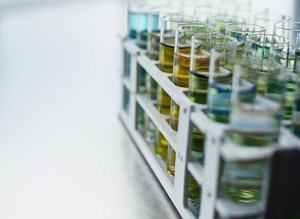Several biologicals will lose patent protection within the next few years, opening up the market for biosimilars [1]. According to US Food and Drug Administration (FDA) guidelines, biosimilar applicants should demonstrate biosimilarity using a stepwise approach, which includes structural and functional characterization, animal toxicity, pharmacokinetics and pharmacodynamics, immunogenicity, and clinical safety and effectiveness [2]. FDA expects extensive characterization of the proposed biosimilar and the reference product using state-of-the-art analytical technology including analysis of the protein (primary, secondary, tertiary, quaternary structure as well as post-translational modifications).
Several analytical methods are available for higher order structural characterization, including, e.g. nuclear magnetic resonance (NMR), X-ray crystallography, electron microscopy, microcalorimetry, mass spectrometry and other methods. However, the spectra from these methods can be complex and difficult to compare.
Boštjan Japelj and colleagues demonstrated the use of NMR coupled with mathematical based similarity metrics for structural comparability of a small protein (filgrastim) and a relatively large protein (monoclonal antibody rituximab) by comparing the respective biosimilars to their reference products [3]. The authors recorded the homonuclear proton as well as heteronuclear amide and methyl fingerprint spectra at natural isotopic abundance, developed methods for spectral processing and several bioinformatics methods whose aim is to summarize the spectra in terms of biosimilarity scores. The comparison between the biosimilar and the reference spectra can be based on global scores, detailed parameters of the individual peaks or image analysis. Biosimilarity scores allow the translation of complex spectral information into simplified scores, which can then be used to estimate the degree of similarity between the biosimilar and the reference product.
Only a limited number of studies have been published so far on structural comparison using NMR [4-6]. There is room for improvement regarding the coverage of large molecule spectra, as shown by Arbogast et al. [6], however, this would not change the overall methodology. The authors strongly believe that such similarity studies will become an objective standard for analysing higher order structure results with the aim to demonstrate structural similarity to reference product in the future.
Conflict of Interest
The authors of the research paper [3] declared that there were no competing financial interests.
Abstracted by Boštjan Japelj, PhD, Senior Scientist, Protein Biophysics and Bioinformatics, Sandoz Biopharmaceuticals, Slovenia.
References
1. Derbyshire M. Patent expiry dates for best-selling biologicals. Generics and Biosimilars Initiative Journal (GaBI Journal). 2015;4(4):178-9. doi:10.5639/gabij.2015.0404.040
2. U.S. Food and Drug Administration. Scientific considerations in demonstrating biosimilarity to a reference product. April 2015 [homepage on the Internet]. [cited 2017 Feb 3]. Available from: http://www.fda.gov/downloads/DrugsGuidanceComplianceRegulatoryInformation/Guidances/UCM291128.pdf
3. Japelj B, et al. Biosimilar structural comparability assessment by NMR: from small proteins to monoclonal antibodies. Sci Rep. 2016;6:32201.
4. Ghasriani H, et al. Precision and robustness of 2D-NMR for structure assessment of filgrastim biosimilars. Nat Biotechnol. 2016;34(2):139-41.
5. Poppe L, et al. Profiling formulated monoclonal antibodies by (1)H NMR spectroscopy. Anal Chem. 2013;85(20):9623-9.
6. Arbogast LW, Brinson RG, Marino JP. Application of natural isotopic abundance ¹H-¹³C- and ¹H-¹⁵N-correlated two-dimensional NMR for evaluation of the structure of protein therapeutics. Methods Enzymol. 2016;566:3-34.
Permission granted to reproduce for personal and non-commercial use only. All other reproduction, copy or reprinting of all or part of any ‘Content’ found on this website is strictly prohibited without the prior consent of the publisher. Contact the publisher to obtain permission before redistributing.
Copyright – Unless otherwise stated all contents of this website are © 2017 Pro Pharma Communications International. All Rights Reserved.








 0
0











Post your comment